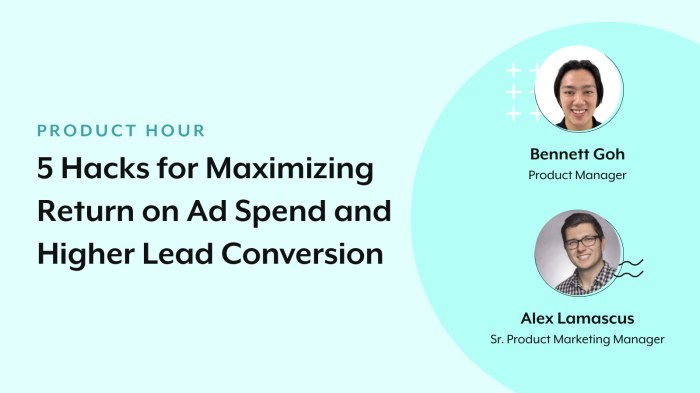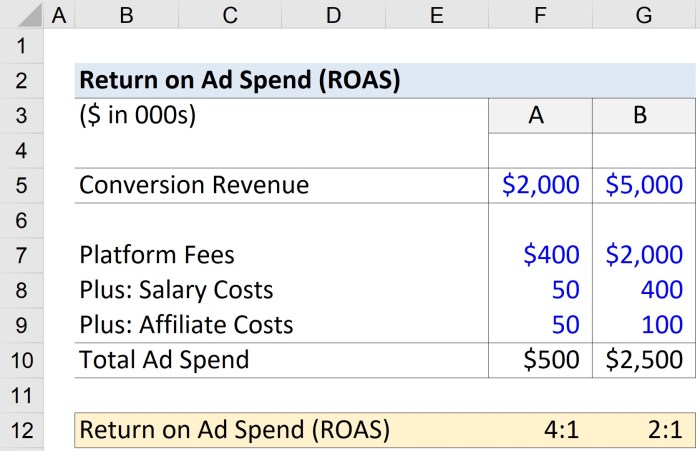Maximizing Return on Ad Spend dives deep into the world of marketing metrics, offering insights into how businesses can optimize their advertising efforts for maximum returns. From understanding the importance of ROAS to exploring strategies for success, this topic is a must-read for marketers looking to boost their ROI.
As we unravel the complexities of Return on Ad Spend, get ready to uncover key factors, strategies, and tools that can revolutionize your marketing game plan and propel your business to new heights.
Understanding Return on Ad Spend (ROAS): Maximizing Return On Ad Spend

Return on Ad Spend (ROAS) is a crucial metric in marketing that measures the revenue generated for every dollar spent on advertising. It helps businesses evaluate the effectiveness of their advertising campaigns and optimize their marketing strategies.
Calculating ROAS
ROAS is calculated by dividing the total revenue generated from advertising by the total cost of the advertising campaign. The formula for ROAS is:
ROAS = Revenue from Advertising / Cost of Advertising
- For example, if a company spends $10,000 on a marketing campaign and generates $50,000 in revenue, the ROAS would be 5 ($50,000 / $10,000).
- A ROAS of 5 means that for every dollar spent on advertising, the company generated $5 in revenue.
Importance of ROAS
ROAS is crucial for businesses as it helps them understand the effectiveness of their advertising efforts. By analyzing ROAS, companies can identify which marketing channels are bringing the highest returns and allocate their budget accordingly. This optimization leads to increased profitability and higher return on investment.
- For instance, if a company discovers that their social media ads have a higher ROAS compared to their print ads, they can reallocate funds to the more profitable channel to maximize their return on ad spend.
- ROAS also allows businesses to track the performance of different campaigns over time and make data-driven decisions to improve their marketing strategies.
Factors Affecting ROAS
When it comes to maximizing Return on Ad Spend (ROAS), there are several key factors that can significantly influence the outcome. Factors such as targeting, ad creatives, landing pages, seasonality, market trends, and the choice of ad platforms all play a crucial role in determining the success of a campaign.
Targeting
Targeting the right audience is essential for improving ROAS. By reaching the most relevant potential customers, you can increase the likelihood of conversions and maximize your return on investment.
Ad Creatives
Compelling ad creatives that capture the attention of your target audience can make a huge difference in the performance of your campaigns. Creative and engaging visuals, copy, and messaging can drive higher click-through rates and ultimately improve ROAS.
Landing Pages
The effectiveness of your landing pages can directly impact ROAS. A well-designed and optimized landing page that aligns with your ad messaging can lead to higher conversion rates and improved ROI.
Seasonality and Market Trends
Seasonal changes and market trends can have a significant impact on ROAS. Understanding these fluctuations and adjusting your strategies accordingly can help you capitalize on peak seasons and stay competitive in the market.
Ad Platforms Comparison
Different ad platforms like Google Ads and Facebook Ads offer unique advantages and challenges when it comes to ROAS. While Google Ads may be more effective for capturing high-intent search traffic, Facebook Ads can be great for targeting specific demographics and interests. Understanding the strengths and weaknesses of each platform is crucial for optimizing ROAS across different channels.
Strategies for Maximizing ROAS

When it comes to maximizing Return on Ad Spend (ROAS), there are several strategies that can be employed to ensure optimal results. By focusing on audience segmentation and targeting, utilizing A/B testing, and learning from successful examples, companies can significantly increase their ROAS.
Audience Segmentation and Targeting
One key strategy for maximizing ROAS is through effective audience segmentation and targeting. By understanding the demographics, behaviors, and preferences of your target audience, you can tailor your ads to resonate with them on a more personal level. This allows for more relevant and engaging ads, ultimately leading to higher conversion rates and improved ROAS.
A/B Testing Importance, Maximizing Return on Ad Spend
A/B testing is another crucial strategy for maximizing ROAS. By testing different variations of your ads, landing pages, or call-to-action buttons, you can determine which elements perform best and optimize accordingly. This iterative process helps in identifying the most effective strategies that lead to increased ROAS over time.
Successful Strategies Examples
Companies like Amazon and Nike have successfully increased their ROAS through innovative strategies. Amazon’s personalized recommendations based on user behavior have led to higher conversion rates and improved ROAS. Nike’s influencer partnerships and user-generated content campaigns have also proven to be effective in driving sales and maximizing ROAS.
Tools and Technologies for ROAS Optimization
When it comes to maximizing Return on Ad Spend (ROAS), having the right tools and technologies in place can make a significant difference in your campaign performance. Let’s explore some popular tools that can help in tracking and optimizing ROAS, as well as the role of AI, machine learning, and automation in improving ROAS.
Popular Tools for Tracking and Optimizing ROAS
- Google Analytics: This powerful tool provides valuable insights into the performance of your ad campaigns, allowing you to track key metrics such as conversion rates, click-through rates, and more to optimize your ROAS.
- Facebook Pixel: Specifically designed for tracking conversions from Facebook ads, the Facebook Pixel helps you understand user behavior and optimize your ad targeting to improve ROAS.
The Role of AI and Machine Learning in Improving ROAS
- AI and machine learning algorithms can analyze data at scale and identify patterns that humans might miss, leading to more effective ad targeting and optimization strategies for higher ROAS.
- These technologies can also help in predicting user behavior and adjusting ad campaigns in real-time to maximize ROI and drive better results.
Leveraging Automation to Enhance ROAS Performance
- Automation tools can streamline repetitive tasks, such as bid management and ad optimization, saving time and resources while improving the efficiency and effectiveness of your campaigns.
- By setting rules and parameters, automation can ensure that your ad spend is allocated to the most profitable channels and audiences, ultimately boosting your ROAS.












